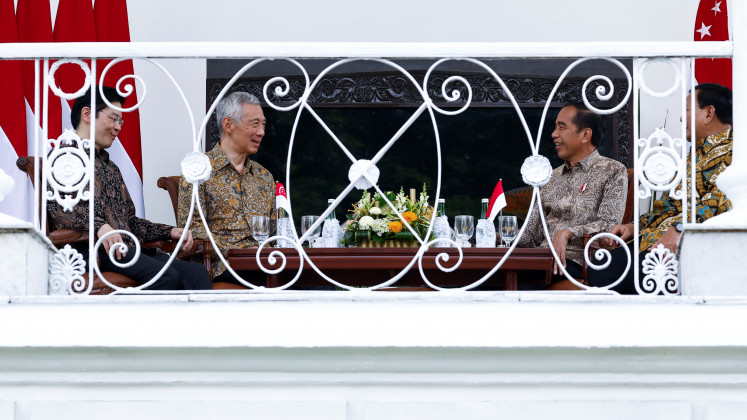Beyond Balinese beauty
Surviving Memories (2009), 40x25x70 cm, fiberglass, electroplating and flower
Change Size

Surviving Memories (2009), 40x25x70 cm, fiberglass, electroplating and flower. JP/Anissa S. Febrina
She was once a muse.
Her Belgian painter husband Le Mayeur captured her in his drawings, encapsulating the famous Balinese dancer Ni Pollok as a peek into the beauty of the paradise island. Decades passed and she remained an icon, a representation.
A different artist has taken the subject matter to another level, raising the issue of Balinese identity that will perhaps forever tickle the mind of Balinese painters. What is Bali, beyond its beauty as a tourism destination?
For I Wayan Suja, Pollok was more than a Balinese beauty. In his realistic canvases exhibited at the National Gallery, she came to represent more than just beauty.
Under a layer of crumpled plastic, the dancer speaks of the reality that is Bali. A sometimes idealized place, consumed by its own constructed beauty.
“Suja’s paintings, to me, are trying to articulate a string of meanings that may arise out of a kind of distance between Ni Pollok’s figure and her visual representation,” curator Rizki A. Zaelani wrote of Suja’s works.
Suja was not trying to reinterpret Mayeur’s works nor his creative process.
“Personally, as a Balinese man and artist, it is as if Ni Pollok has paved the way for discovering important issues that I have never realized before,” Suja said as quoted by Zaelani in his curatorial article.
In the eight works that Suja brings to the public, the well-known former palace legong dancer from Kelandis is wrapped in plastic: A reinterpretation of Pollok as an object of consumption. It is Suja’s way of bringing sharp criticism of Bali to the surface in a very subtle way.
“From this perspective, Ni Pollok is a blessing and a reminder not to get trapped in the excessive cultism of tourism. Criticizing tourism is a way to retain tourism itself,” added Hardiman who also curated the exhibition.
Suja chose to wrap the beauty icon in layers of plastic, the image of which is closely related to artificiality, fakeness and the ever-increasing consumption of the globalized world. We’ve all had a love-hate relationship with one of the symbols of modernity that is plastic.

Under such layers, Pollok has been transformed into a distanced, packaged beauty.
Ni Pollok’s and Le Mayeur’s role in the construction of Bali tourism was taken to its highest level as former President Sukarno declared Mayeur’s residence a museum, he added. It was a part of a series of Bali tourism constructions.
“If we are willing to see this reality more critically, Ni Pollok, in this regard, is a figure who has been placed as a tourism object, whether one realizes it or not,” Hardiman continued.
During her days, the muse herself knew only too well what her role was. As a woman, she had wanted to have a child, but her husband’s disapproval denied her motherhood.
“The reason that was given to me hurt my female heart ‘If Pollok carries a baby, your body will turn ugly. Pollok can no longer be a model’,” the dancer said in her biography written by Yati Maryati Wiharja.
Being a Balinese woman of her era, she chose to submit, though not without regret.
“He preferred seeing me as a model to being a mother, a true woman. Do forgive us, Lord … who among the two of us is sinful,” Pollok cried out her disappointment.
She was an object aware of being an object. Her body has become a narcissistic cult object, as Baudrillard reaffirmed in the concept of the functional body, Hardiman pointed out. Reinterpreted as a packaged beauty, Pollok’s anxiety surfaces.
“A package, although it is beautiful, may have a face of anxiety.”
Mythical Beauty
A solo exhibition by I Wayan Suja
Dec. 10 - 20, 2009
The National Gallery
Central Jakarta.









